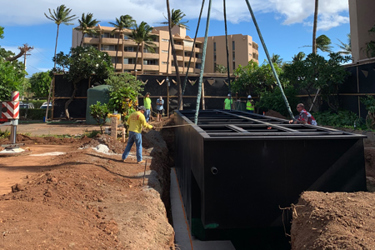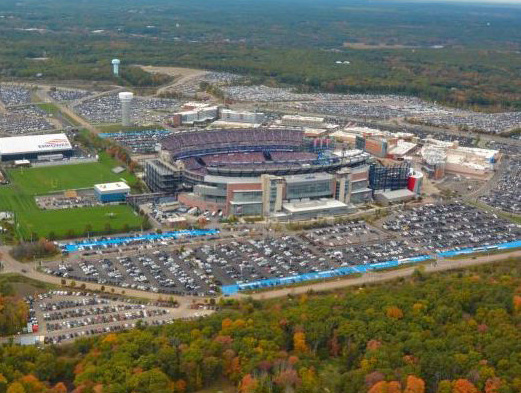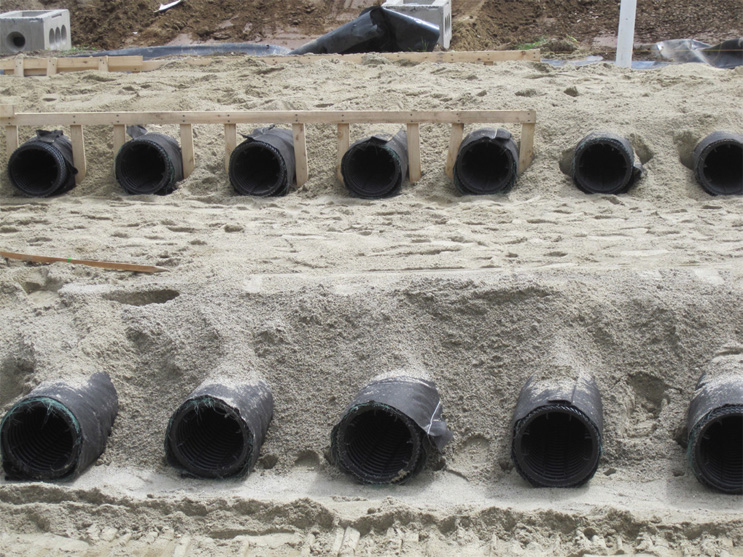The Future Of Decentralized Onsite Wastewater Treatment Systems
By Ashley Donnelly and Dennis F. Hallahan

Numerous factors coalesce to create a rising demand for decentralized solutions.
Decentralized systems are a part of the nation’s wastewater treatment infrastructure and play a significant role in protecting public health and the environment, and the future of the industry is promising. The decentralized system industry has greatly developed with new technologies, regulatory programs, and expanding professional organizations. On the horizon there continue to be many new challenges to face, including increased treatment limits, the implementation of regulations to address nutrients and contaminants of emerging concern (CECs), which are chemicals and toxics that have been found in waterbodies that may cause ecological or human health crises. Further, groundwater resources are quickly becoming depleted.
The good news is that managed aquifer recharge offers many benefits in this challenging situation. With the traditional practice of extending centralized sewers as a solution to wastewater challenges no longer taken for granted — being financially unfeasible in many cases — communities are turning to decentralized solutions. These and other challenges and developments will help realize a promising future for decentralized solutions.
Decentralized Industry Milestones
The decentralized wastewater treatment industry has made significant gains in the past, most notably in 1997 when the U.S. EPA issued a report to the U.S. Congress that stated: “adequately managed decentralized wastewater systems are a cost-effective and long-term option for meeting public health and water quality goals ...” This was a watershed moment for the decentralized industry. Prior to this point, nothing had been written about the long-term status of the industry, and onsite wastewater systems were only viewed as a short-term solution until sewers were available.
Key to the development of the industry and associated technologies since that time is a trained, professional base of onsite experts, including those benefiting from continuing education credits. Innovation in the form of advanced treatment to address nutrients was a huge step forward and is now the norm in many states with environmentally sensitive areas. Operations and maintenance (O&M), once the Achilles’ heel of the industry, are now seen as critical to many decentralized system designs, and programs continue to evolve to ensure system performance and longevity.
Future Direction Of The Decentralized Wastewater Industry — An Ever-Evolving Landscape
Where the decentralized industry is going can be described by one challenge that we all face: change. Change is one of the realities that all people and businesses must embrace to remain viable. Businesses that haven’t responded to change, such as video movie rental stores and suburban malls, fail. Changes in technology, pollution constituents, population, and climate will all shape the future of the decentralized industry.
Focus on Advanced Treatment to Combat Contaminants
regulatory perspective, this is no easy step. The technologies are the easy part. It’s the politics that can slow down the adoption of new approaches and the selection of the right solution for a community’s problem. Community leaders and residents must first be convinced that there is an environmental problem that requires a new solution. Then the hard work of dealing with a disgruntled public that, wary of the sticker price of the necessary upgrade, requires education. Next, creating and funding an O&M program can add to the cost of treatment and complicate gaining approval.
Nutrients of Concern — Nitrogen, Phosphorus, PFAS, and Microplastics
Nitrogen
Nitrogen continues to be one of the major environmental challenges that communities face, including nitrogen reduction and higher overall treatment standards, as well as a series of new technologies introduced by manufacturers.
Phosphorus
Phosphorus has come to the forefront as the limiting nutrient in freshwater ecosystems. Regulatory requirements related to phosphorus have been introduced in Ontario, Florida, and New York, and this is just the beginning. In addition, more stringent regulations include the introduction of new effluent limits for CECs such as PFAS.
PFAS
While still new to many wastewater professionals, PFAS are hot on the radar screen and are a popular topic at all the major conferences. The EPA has set regulations for PFAS in drinking water, so it is only a matter of time before the EPA carries that guidance over to wastewater. These per- and polyfluoroalkyl substances stem from a large group of synthetic chemicals used in consumer products since the 1950s. PFAS have over 9,000 compounds and can be found in nonstick cookware, carpeting and stain-resistant clothing treatments, outdoor clothing waterproofing, and the material that makes dental floss slippery, to name just a few. Labeled “forever chemicals” because of their strong carbon-fluorine bond, PFAS are hard to break down by normal treatment processes. The health concerns are still being understood, but PFAS can remain in the human body and elsewhere in the environment for decades. The EPA says there are thousands of different types with potentially varying effects and toxicity levels. Researchers have linked them to reduced liver and kidney function, cancer, birth defects, and hormone disruption. Drinking water is considered a major pathway for human exposure.
Microplastics
Microplastics are another contaminant gaining national attention. These tiny particles of manufactured or decayed plastics from various sources have been found everywhere from the Arctic to U.S. tap and bottled drinking water. It is estimated that food intake results in the consumption of up to 52,000 microplastic fragments per person each year, and microplastics have even been found in human blood. The toxicity of plastics in the food chain and within our bodies can lead to numerous health disorders. Regulations have not yet been proposed for microplastics, but this is not far off. One benefit of decentralized systems with subsurface disposal is that the soils can be an effective filtering and treatment mechanism for these elements, reducing their impact on the water supply.
Innovative Decentralized Approaches
Replenishing large volumes of groundwater at point of source with managed aquifer recharge incorporating reuse at Gillette Stadium in Foxboro, MA
When the new Gillette Stadium was constructed in 2000, the wastewater treatment system was required to be upgraded according to current state codes. A wastewater treatment plant (WWTP) was designed for 250,000 GPD (945 m3/d) following a 680,000-gallon (2,575 m3) flow equalization tank to accommodate the 1 MGD (3,785 m3/d) design flow from the stadium during events. The wastewater is treated to a level acceptable for reuse for toilet flushing. The wastewater is then returned to the stadium for reuse when needed or discharged to subsurface disposal chamber beds installed below the parking lots for groundwater recharge.

Gillette Stadium
Strict effluent requirements achieved with extended aeration wastewater treatment system at Lauloa Maalaea Resort in Maui, HI
With stringent effluent quality requirements and limited space onsite at the Lauloa Maalaea Resort in Hawaii, the engineer specified an extended aeration package wastewater treatment plant. To meet the new regulatory requirements and the design flow of 21,000 GPD, the extended aeration process selected for this system utilizes flow equalization, aeration, clarification, and disinfection.
The flow equalization chamber receives the incoming wastewater, then duplex pumps discharge the wastewater to the aeration chamber. Duplex positive displacement blowers and an air distribution manifold system supply air to the system, including air diffusers, airlift pumps, and a skimmer. The hopper-style clarifier has baffling to prevent short circuiting and to provide the maximum uniform solids settling area. The settled sludge returns from the clarifier to the aeration chamber through the positive sludge return system. Immediately following the clarifier is a chlorine contact chamber. The influent characteristics were typical domestic waste loadings, with effluent requirements of less than 20 mg/L biochemical oxygen demand (BOD)/total suspended solids (TSS).
Community WWTP upgrade utilizing passive, decentralized, onsite wastewater treatment in Newbury, NH
In 2001, the community of Blodgett Landing in Newberry was faced with the decision of investing in a wastewater treatment plant or upgrading the existing treatment system installed in 1959. For half the cost of a WWTP, the community decided to implement a passive treatment, denitrification, and dispersal system. An Enviro-Septic treatment system was specified for a design flow of 50,000 GPD. The Enviro-Septic pipe uses passive filtration with recirculation and bacterial ecosystems, eliminating the use of harmful chemicals or an external power source. The green treatment process enabled the community to protect its natural resources.

Construction of multilevel treatment beds. Wooden spacers are used to hold pipes during backfill.
The Bottom Line
One of the biggest limitations in the decentralized industry has been funding. While decentralized systems serve approximately 25% of the population, they received only a fraction of federal wastewater treatment and environmental funding. Fortunately, many years of lobbying by the National Onsite Wastewater Recycling Association (NOWRA) is beginning to turn the tide. While still not equivalent to centralized system infrastructure, there have been significant gains.
The future is looking bright for the decentralized industry, technology, rules development, and investment. The evolution of the decentralized industry is staggering, and this article only touches on some of the changes. Additional hot developments include sensors, automation, privatization, AI, contractor’s equipment, and nonbiological methods of treatment. This is great news for the industry, as it offers opportunities for professionals, communities, and manufacturers. Most promising of all is the positive impact these developments will provide to the most important goal: protecting public health and the environment.
About The Authors

Ashley Donnelly, technical training and sales development manager at Infiltrator Water Technologies, has a passion for building relationships within the onsite wastewater treatment industry through training and technical education. She manages the inside sales team and is responsible for maintaining and building customer relationships, including assisting engineers, contractors, and regulators with technical and design information, training, installation, and O&M. adonnelly@infiltratorwater.com.

Dennis F. Hallahan, PE, is the technical director of Infiltrator Water Technologies. Dennis has over 30 years of experience with the design and construction of decentralized wastewater treatment systems. He has authored numerous articles for onsite industry magazines and regularly gives presentations nationally on the science and fundamentals of onsite wastewater treatment systems. Dennis also serves on various national industry association wastewater committees. dhallahan@infiltratorwater.com
